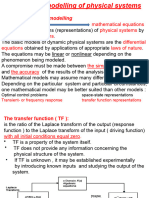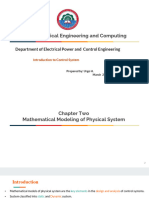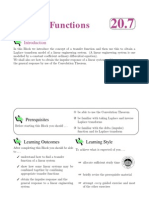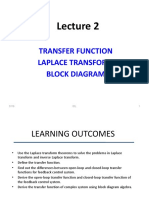0 ratings0% found this document useful (0 votes)
96 viewsFeedback
This document discusses modeling systems using transfer functions in the frequency domain. It introduces the Laplace transform, which allows representing inputs, outputs, and systems as separate algebraic entities. This simplifies modeling physical systems. The transfer function is defined as the ratio of the Laplace transform of the output to the Laplace transform of the input, assuming all initial conditions are zero. Examples are provided of finding transfer functions from systems represented by differential equations and vice versa.
Uploaded by
April BalceCopyright
© © All Rights Reserved
We take content rights seriously. If you suspect this is your content, claim it here.
Available Formats
Download as PPTX, PDF, TXT or read online on Scribd
0 ratings0% found this document useful (0 votes)
96 viewsFeedback
This document discusses modeling systems using transfer functions in the frequency domain. It introduces the Laplace transform, which allows representing inputs, outputs, and systems as separate algebraic entities. This simplifies modeling physical systems. The transfer function is defined as the ratio of the Laplace transform of the output to the Laplace transform of the input, assuming all initial conditions are zero. Examples are provided of finding transfer functions from systems represented by differential equations and vice versa.
Uploaded by
April BalceCopyright
© © All Rights Reserved
We take content rights seriously. If you suspect this is your content, claim it here.
Available Formats
Download as PPTX, PDF, TXT or read online on Scribd
You are on page 1/ 11
MODELING IN
FREQUENCY DOMAIN
In previous topic, we discussed the analysis and design
sequence that included obtaining the system’s schematic and
demonstrated this step for a position control system. To obtain a
schematic, the control systems engineer must often make many
simplifying assumptions in order to keep the ensuing model
manageable and still approximate physical reality.
The next step is to develop mathematical models from
schematics of physical systems. We will discuss two methods: (1)
transfer functions in the frequency domain and (2) state equations
in the time domain. As we proceed, we will notice that in every
case the first step in developing a mathematical model is to apply
the fundamental physical laws of science and engineering. For
example, when we model electrical networks,
Ohm’s law and Kirchhoff’s laws, which are basic laws of electric
networks, will be applied initially. We will sum voltages in a loop
or sum currents at a node.
LAPLACE TRANSFORM
REVIEW
A system represented by a differential equation is difficult to
model as a block diagram. Thus, we now lay the groundwork for
the Laplace transform, with which we can represent the input,
output, and system as separate entities. Further, their
interrelationship will be simply algebraic. Let us first define the
Laplace transform and then show how it simplifies the
representation of physical systems.
The Laplace transform is defined as:
where , a complex variable. Thus, knowing f(t) and that the
integral in Eq. above exists, we can find a function, F(s), that is
called the Laplace transform of f(t).1
LAPLACE TRANSFORM
REVIEW
The inverse Laplace transform, which allows us to find f(t) given
F(s), is
LAPLACE TRANSFORM
REVIEW
Laplace Transform Table
LAPLACE TRANSFORM
REVIEW
Laplace Transform Theorem
LAPLACE TRANSFORM
REVIEW
Example 1. What is the Laplace Transform of 1?
Example 1. What is the Laplace Transform of t?
TRANSFER FUNCTION
Transfer function is the ratio of Laplace Transform of output to
the Laplace Transform of input, when all the initial conditions
are assumed to be zero.
input SYSTE output
R(s) r(t) MG(s)g(t) c(t)
C(s)
Where: G(s) – Transfer Function of the System.
C(s) – Output of the System.
R(s) – Input of the System.
TRANSFER FUNCTION
Transfer function is the ratio of Laplace Transform of output to
the Laplace Transform of input, when all the initial conditions
are assumed to be zero.
C(s)
G(s) =
R(s) initial condition is equal to zero.
TRANSFER FUNCTION
Example 3. Find the Transfer Function of the System given by:
TRANSFER FUNCTION
Example 4. Find the Transfer Function of the System given by:
TRANSFER FUNCTION
Example 4. Find the differential equation corresponding to the
transfer function:
You might also like
- Annual Accomplishment Report in Mathematics S.Y 2016-2017100% (8)Annual Accomplishment Report in Mathematics S.Y 2016-20173 pages
- Learning Module 2. Mathematical EquationsNo ratings yetLearning Module 2. Mathematical Equations6 pages
- 002 ME31002 - Transfer Function-2020decNo ratings yet002 ME31002 - Transfer Function-2020dec28 pages
- St3573 Imt8a Garcia Macias Jimena Investigationp2No ratings yetSt3573 Imt8a Garcia Macias Jimena Investigationp210 pages
- Chapter 2 Modeling in The Frequency DomainNo ratings yetChapter 2 Modeling in The Frequency Domain3 pages
- SDP_2__Modeling_in_the_frequency_domainNo ratings yetSDP_2__Modeling_in_the_frequency_domain57 pages
- Clase 02 Modelado de Sistemas de Control PDFNo ratings yetClase 02 Modelado de Sistemas de Control PDF40 pages
- EMS507 Lecture 2 - Transfer Function and Block DiagramsNo ratings yetEMS507 Lecture 2 - Transfer Function and Block Diagrams20 pages
- ECM2105 Control: Prathyush P Menon, Christopher Edwards Date: 20-Jan-2014, Room H101No ratings yetECM2105 Control: Prathyush P Menon, Christopher Edwards Date: 20-Jan-2014, Room H10118 pages
- CHAPTER 1 Modeling in The Frequency DomainNo ratings yetCHAPTER 1 Modeling in The Frequency Domain17 pages
- Modeling of Systems (2) : Majid Medhat Saeed Phd. Student Mechanical Engineering DepartmentNo ratings yetModeling of Systems (2) : Majid Medhat Saeed Phd. Student Mechanical Engineering Department34 pages
- 2023 LESSON 2 - Laplace Transform and Transfer Functions.v1No ratings yet2023 LESSON 2 - Laplace Transform and Transfer Functions.v137 pages
- Application of The Laplace Transform To The Analysis of Electrical CircuitsNo ratings yetApplication of The Laplace Transform To The Analysis of Electrical Circuits6 pages
- Feedback Control System: Output - Desired OutputNo ratings yetFeedback Control System: Output - Desired Output13 pages
- (eBook PDF) Fundamentals of Electric Circuits 7th Edition instant download100% (1)(eBook PDF) Fundamentals of Electric Circuits 7th Edition instant download51 pages
- Journal For Research: First Author Second AuthorNo ratings yetJournal For Research: First Author Second Author9 pages
- Chapter Six 6. Production and Cost Analysis 6.1 Production Function100% (1)Chapter Six 6. Production and Cost Analysis 6.1 Production Function15 pages
- Embeddings in Natural Language Processing Theory and Advances in Vector Representations of Meaning 1st Edition Mohammad Taher Pilehvar 2024 Scribd Download100% (5)Embeddings in Natural Language Processing Theory and Advances in Vector Representations of Meaning 1st Edition Mohammad Taher Pilehvar 2024 Scribd Download55 pages
- Lab 6 Calculus For It 501031: 1 ExercisesNo ratings yetLab 6 Calculus For It 501031: 1 Exercises2 pages
- Feature Selection and Similarity Coefficient Based Method For Email Spam FilteringNo ratings yetFeature Selection and Similarity Coefficient Based Method For Email Spam Filtering4 pages
- A Level Further Mathematics For OCR A Pure Core Student Book 1 Practice Paper SolutionsNo ratings yetA Level Further Mathematics For OCR A Pure Core Student Book 1 Practice Paper Solutions4 pages
- Maintenance Audits Handbook A Performance Measurement Framework 1st Edition Diego Galar Pascual - The ebook is ready for instant download and access100% (1)Maintenance Audits Handbook A Performance Measurement Framework 1st Edition Diego Galar Pascual - The ebook is ready for instant download and access50 pages

































































































